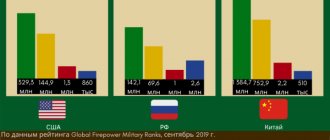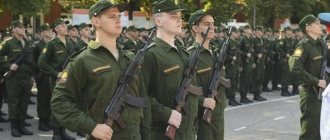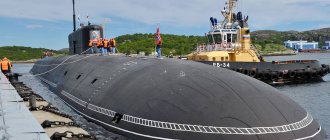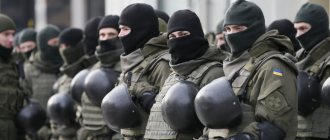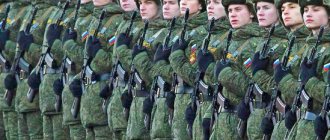A soldier's ration or individual diet (IRP) is a set of products that is intended to feed military personnel in conditions close to combat. It is also used by hunters, fishermen and tourists who do not have the opportunity to prepare hot food in the field.
According to buyers, the popularity of different types of this food is due to its availability, optimal energy value and ease of digestibility. In addition, such sets are sold in many online stores, where anyone can buy them.
What is an individual diet for soldiers of the IRP?
Such sets are used to nourish and maintain energy in the body.
Dry rations are given to one person or group of people for 1 meal or for several days.
REFERENCE! Civilians have the right to receive dry rations if circumstances do not allow preparing hot food.
The first food packages began to be issued to military personnel during the Franco-Prussian War (1870-1871). The reason for their massive appearance was the desire to increase the mobility of troops.
In Germany, during the reign of the emperor, soup concentrates with legumes were used as IRP. Later, this idea was supported by large states: the USA, France, and the Russian Empire.
The composition of an individual diet is calculated in the laboratory and tested in field and garrison conditions. Modern IRP includes products that are consumed hot and cold. Some components of the set do not require heat treatment. Such boxes can be stored for 2–3 years.
Sukhoi rations in the Russian army
The composition of the kits is specified in the order of the Minister of Defense of the Russian Federation No. 888 dated June 21, 2011. Until this time, there were 2 main types of diet - combat and everyday. Today, soldiers and officers receive the same IRP. The range of products depends on the type of troops. 7 variants of dry rations have been developed for the army. The food is in a cardboard box, which is covered with waterproof wrapping.
REFERENCE! This set is designed for 3 meals . In 2022, the main manufacturers of dry rations were the Barysh meat processing plant and the Gryazinsky food plant. Each manufacturer has the right, within the framework of the requirements, to complete the kits at its own discretion. Therefore, sets from different batches of the same plant may differ.
IRP combined arms version 2
Let’s look at what the set is: “Individual combined arms diet, option 2.” The inscription on the box: Voentorg. Not for sale. Produced by order of Voentorg JSC. Location: 119160, Russia, Moscow, Bolshaya Pirogovskaya st., 23.
Completed: 02/20/2019. Expiration date: 12/20/2020. Manufacturer: PJSC Gryazinsky Food Plant. Production address: Russia, 399053, Lipetsk region, Gryazinsky district, Gryazi, Tchaikovsky St., 4. Packing option: 2. Nutritional value of the diet: energy value/calorie content - 19888 kJ/4750 kcal. Protein 102.3 grams, fat 293.3 grams, carbohydrates 430.3 grams. Storage conditions: at temperatures from 0 to +20C and relative humidity no more than 75%. Gross weight: 2.1 kg.
If necessary, you can make a handle for carrying the army IRP: Russian Army. Individual diet. Not for sale.
We open the cardboard package and see a hole in the cardboard box through which it can be pulled out of the package:
Inside the package there is sealed foil, which protects the contents, including from moisture: We remove the box (weighing 2.1 kg) and see compactly folded products:
Chewing gum (10 tablets). Chewing gum coated with mint and menthol flavors. Ingredients: white sugar, rubber base, molasses, flavorings (mint and menthol), humectant (E422), emulsifier (E322), food coloring (E171), thickener (E414), glazing agent (E903), antioxidant (E321).
Chewing gum with mint and menthol flavors. Net weight: 11 grams. Dry natural instant concentrate: Peach. Instant drink with natural ingredients, enriched with vitamins. Net weight: 25 grams. Dry natural instant concentrate: Cherry.
Ingredients: white crystalline sugar, stabilizer - pectin, acidity regulator - citric acid, dry cherry juice concentrate, natural "Cherry" flavoring, natural food coloring - beet extract, vitamin C, vitamin premix (vitamins PP, B5, B6, B9).
Dry natural instant concentrate: Raspberry. After opening the package, store the product at a temperature from 0 to 20C for no more than 24 hours. Apple jam. Unsterilized apple jam - net weight 45 grams.
Portable heater RP3. Contents: 3 tablets of dry fuel, metal taganok, packaging. Instructions for use on the package:
Warranty period for heaters: 36 months from the date of manufacture. At a temperature of no more than plus 40C and a relative humidity of no more than 85%.
Konservprom. Canned minced meat, sterilized. Canned salted bacon. Net weight - 100 grams.
On the back of the can, production date: 12/28/2018.
Buckwheat porridge with beef. GOST Net weight: 250 grams. Ingredients: beef, buckwheat, beef fat, water, refined sunflower oil, onion, salt, ground black pepper. Manufacturer: KonservPakLam LLC. Russia, 399053, Lipetsk region, Gryazinsky district, Gryazi, Tchaikovsky st., 4. *This is not a supplier: the Baryshsky meat processing plant, which is associated with a high-profile case regarding the supply of dry rations for the needs of the Russian Guard and the Ministry of Defense. More expensive beef, according to investigators, was replaced with cheaper chicken. Thus, according to the findings of the Investigative Committee, the accused stole budget funds in the amount of 220 million rubles. This criminal case involves: the main owner of Baryshsky Meat Processing Plant LLC and the general director of the group, Mikhail Lakshin, as well as his closest associates - the owner of Baryshsky Cannery LLC, Mikhail Rodnikov, and the general director of Mtsensky Meat Processing Plant LLC, which is part of the Group of Companies, Dmitry Atroshchenko.
Date of manufacture on the bottom of the jar: 01/16/2019.
Goulash with potatoes. Ingredients: beef, potatoes, water, beef fat, tomato paste, refined sunflower oil, carrots, onions, salt, sugar, flour, white root, ground red pepper, ground bay leaf. THAT. Ruscon. Net weight: 250 grams. Canned meat and vegetables. The second dish is meat with a side dish. Canned meat and vegetables, chopped, sterilized.
Date of manufacture: 12/18/2018. Expiry date: 12/17/2021.
Beef meatballs. Ingredients: beef, water, beef fat, starch, tomato paste, onion, acetic acid, salt, sugar, flour, ground black pepper, ground red pepper, ground bay leaf. GOST Ruscon. Net weight: 250 grams. Canned meat. Second meat dishes without side dishes. Canned minced meat, sterilized.
Date of manufacture: 12/15/2018. Expiry date: 12/14/2021.
Vegetable stew (zucchini, sweet peppers, refined sunflower oil, water, rice, tomato paste, carrots, onions, tomatoes, salt, sugar, garlic, parsley, ground allspice, ground black pepper). GOST Production: Ruscon.
Date of manufacture: 12/20/2018.
Amateur sausage mince. Ingredients: beef, pork, lard, animal fat, water, potato starch, flour, salt, sugar, garlic, ground black pepper, ground allspice, ground nutmeg, ground coriander, nitrite salt (table salt, sodium nitrate), regulator acidity (E339, E451), emulsifiers (E450, E452). Ruscon. Net weight: 50 grams.
Shelf life is no more than 3 years from the date of manufacture. Date of manufacture: 01/18/2019. Expiration date: 01/17/2022.
The pate is tender. Ingredients: pork liver, beef brains, poultry meat, pork fat, lard, water, potato starch, onion, salt, sugar, ground black pepper, ground white pepper, ground nutmeg, ground cinnamon, ground cloves. Ruscon. Net weight: 50 grams.
Date of manufacture: 01/31/2019. Expiration date: 01/30/2022. Apple puree. Manufacturer: LLC Ruskon Food Products Production Plant. Net weight: 100 grams. Date of manufacture: 12/22/2018.
Processed canned sterilized cheese. Weight: 80 grams. Manufacturer: MasLi LLC. Production address: Russia, Murom, Vladimir region, st. Energetikov, building 1a. THAT. The mass fraction of fat in dry matter is at least 55%.
Date of manufacture: 12/17/2018.
Two packs: army biscuits made from wheat flour, net weight: 50 grams (each pack). Each pack contains 8 biscuits. Production date: 12/26/2018. Shelf life: 24 months.
Manufacturer: JSC Visit. Production address: Russia, 442530, Penza region, Kuznetsk, Ordzhonikidze street, 92. Photo of the packaging from the back:
Two packs: army biscuits made from 1st grade wheat flour, weighing 50 grams each pack. Each pack contains 8 biscuits. Production date: 12/25/2018. Shelf life: 24 months.
Photo of the packaging from the back: Bitter chocolate “Officer Standard”. GOST Date of manufacture: 12/25/2018. Expiration date: 12/25/2020. Indian black tea granulated. Royal elephant. GOST Two bags included. Date of manufacture: 12/20/2018. One package of instant coffee (granulated): Weight: 2 grams. Manufacturer: Mas Li LLC. GOST
Instant dry cream. Dry instant mixture with cream flavor based on vegetable fats. 1 packet for 200 ml of tea or coffee.
The composition does not consist of palm oil: corn stream, vegetable oil, sodium caseinate. Three packets of white crystalline sugar. Category: TS2. Beetroot. Net weight: 20 grams. Evaporated food grade salt. Top grade. GOST Photo from the back:
Three packs: a disinfectant wipe for cleaning and disinfecting the skin, cutlery and equipment.
. Russia, 199106, St. Petersburg, Shkipersky Protok St., 14, building 8, letter D. Shelf life: 24 months.
Ground black pepper. GOST 1 gram: On the reverse side: Disinfectant tablet for water. The set contains three pieces: On the reverse side: Multivitamin mineral complex V-MIN. Photo from the back: Package with six “hunting matches” and a cherkash (grating plate). The matches are water and wind resistant. THAT. Shelf-life Unlimited.
In addition to three plastic spoons (tablespoons), a plastic knife, and three paper napkins, the kit includes various waste paper (for ignition). Instructions for using an individual diet:
Recommendations for dietary intake: Additional information on dietary supplement “V-MIN Multivitamin Mineral Complex”: On the reverse side:
What is included in a soldier's packed lunch?
Typically, an IRP is issued during an exercise. The army kit necessarily includes the following products:
- biscuits;
- canned meat and vegetables;
- lard;
- canned fruit;
- processed cheese;
- sugar;
- jam and fruit concentrate;
- fruit stick;
- milk drink;
- chocolate;
- black long tea;
- instant coffee;
- salt and pepper.
Additionally, the IRP includes 6 napkins, 6 matches, 1 portable heater, 1 table knife, 3 plastic spoons, and a pack of chewing gum. Soldiers are given 3 disinfectant tablets and multivitamins.
The usual composition of the IRP and products prohibited from inclusion
Typically, dry rations include the following food products:
- Canned food: stew, condensed milk, canned porridge, stew.
- Freeze-dried or dried foods: instant soups or borscht, dried fruits, milk powder, instant coffee, juices.
- Crackers, crackers or biscuits.
- Vitamins and food additives (spices, salt, sugar).
In addition to food, the dry ration should include disposable tableware , napkins, devices for heating food and means for disinfecting water. As a rule, water is not included in the IRP. To heat food, dry fuel and various burners of the simplest design are usually used. In the past, some armies' packed rations also included cigarettes and condoms, but this practice has long been abandoned. As a rule, the foods included in packed lunches can be eaten cold, but in this case they will not be as tasty and will be less easily absorbed by the body.
Dry rations should not include:
- Any perishable products that require special storage conditions (temperature, humidity level, etc.).
- Products that contain alcohol, a large number of spices, natural coffee, confectionery and cooking fats, table salt with a content of more than 0.8%, most preservatives.
- Confectionery products with a high cocoa content or containing cream fillings.
- Fresh fruits and vegetables.
- Any food products whose quality and safety have not been confirmed by laboratory tests.
What is the composition of army dry rations
Army food kits were developed in laboratories based on the body's energy costs.
The packaging contains a table with the exact composition of nutrients.
To maintain the body, a soldier must receive a certain amount of proteins, fats and carbohydrates per day.
For different types of troops, the ratio of nutrients is different: dry rations for special forces will be higher in calories than for infantry.
Calorie content
A soldier weighing 70 kg is supposed to consume 2500 calories per day. In Russian army kits, this figure is much higher - from 3600 to 4700 calories, depending on the manufacturer. The amount of proteins does not exceed 120 g, fats are 200 - 300 g. The packed lunch contains a lot of carbohydrates - from 370 to 421 g, depending on the set. The energy value varies between 19012 - 19707 kJ.
REFERENCE! IRP No. 5 is characterized by the highest calorie content – 4707 calories. The least amount of calories is obtained after consuming IRP No. 2 - 3670.
Basic requirements for dry soldering
Products included in individual kits must meet several conditions. The Ministry of Defense puts forward the following requirements for the composition of the diet:
- The products are ready to use or can be quickly prepared in the field.
- The food does not cause stomach problems and is suitable for people with food allergies.
- The kit does not include any perishable food to ensure it has a long shelf life. Vegetables, fruits and meat are included in the set in the form of meatballs, stews, jam and marmalade.
- The kit must be nutritious and contain enough nutrients so that the soldier can withstand the load in any situation.
- Products are placed in strong packaging that protects from moisture and dirt. The wrapper has handles for easy carrying of sets weighing 1.5 - 2 kg.
The IRP includes products that have been tested in the laboratory. Dry rations do not include products with alcohol, large amounts of seasonings, confectionery fats, natural coffee, or preservatives. They do not contain desserts with a lot of cocoa and cream.
Types of soldier rations
Before ordering online IRP, you need to determine what types of these food kits there are. There are several classifications of soldiers' dry rations. Each of them presents sets that have certain characteristics, as well as having their own advantages and disadvantages.
Classification by purpose:
- Everyday. Dry rations of this type include food sets intended for a one-day meal. Such kits can contain a wide variety of dishes that do not require cooking, as well as various devices for heating food in the field.
- Combat (for one person or a group of people). This type of dry rations is used only in the event of the outbreak of hostilities or during military exercises. Such food sets are higher in calories than everyday ones. They also have a longer shelf life and contain many auxiliary items.
- Individual (mountain, custom, preventive, rations for airplane and helicopter crews, etc.). These dry rations are intended for one-time or one-day meals. They have different menu options, which take into account the characteristics of the troops or the combat missions they perform.
Types of dry rations
Previously, there were combat and everyday food rations (IRP-B and IRP-P). The first one was characterized by higher calorie content. Everyday kits were produced by various enterprises commissioned by the Ministry of Defense. Today, differences in recruitment are associated with different types of troops and security forces. To provide variety in food, we have developed 7 menu options.
Officer
There are no significant differences between officer and soldier individual diets. The IRP can be increased, then an additional 250 g of stewed beef is included with the main courses.
20 g of dried fish is added to the composition. Such dry rations are higher in calories than soldiers' rations.
General's packed lunch
In Russia there are no separate army recruitments for generals. Representatives of senior officer ranks additionally receive individual dry rations for the holidays. The IRP in honor of May 9 included, in addition to standard products, a can of sprat, stewed turkey or pork with white sauce, and a package of juice. The list includes Frontovaya souvenir products, which consist of 0.25 ml of vodka and a plastic glass.
Conscript's packed lunch
During a trip to the place of service, the conscript receives an IRP with the composition of products depending on the menu number. This kit is intended for each person for 1 day or a group kit is issued for several days. You can eat this diet for up to 7 days. In this case, a trip longer than 6 hours is considered a full day.
Dry rations of the modern Russian army
In the mid-90s, the rear service of the Russian army began to develop a new dry ration, since the old Soviet IRP not only did not correspond to the spirit of the times, but simply looked like a mockery against the backdrop of Western rations that flickered every now and then on the TV screen.
The result of this work was the creation of an “Individual Diet”, which had two main varieties - field (IRP-P) and combat (IRP-B). The composition of these dry rations was officially regulated by order of the head of the military department dated July 24, 2000.
The equipment of the Russian IRP is built on the European (Soviet) principle, that is, one ration contains the amount of food that is enough to feed one soldier for a day. The caloric content of IRP-B is 3590 kcal, and IRP-P is 3360 kcal.
The “individual diet,” of course, was a huge step forward compared to Soviet dry rations. It surpassed the latter in all respects: ease of packaging, range of products, taste. The new IRP includes canned fish, dried fruits, instant coffee, jams, sausages, processed cheese and much more. Both rations had many menu options, so the soldiers did not get bored. Also included in each package were burners for heating, dry fuel, napkins, dishes, and matches. Each IRP was divided into three compartments: breakfast, lunch and dinner. In 2014, at the initiative of Shoigu, the design of the Russian dry ration was changed, and a single form of packaging was introduced for all IRPs.
In addition to the most common IRP-P and IRP-B, there are other types of similar food supplied to the Russian army, which are intended for use in special situations. There is a higher calorie ration for reconnaissance and special forces units. There are food kits for helicopter and airplane crews in distress. There is also an emergency dry ration for sailors. Special diets have been developed for divers, military personnel dealing with toxic and radioactive substances, and for pilots stationed at alternate airfields. There are also FSB dry rations and special “mountain” rations.
Norm of dry rations
Soldiers and officers receive IRP in the same packages, but the products in them may differ. To prevent monotony in food, 7 types of menus were developed for the sets. The number of the specific variant is stamped on the side of the box. IRP No. 1 includes the following products:
- biscuits – 4 packs of 50 g;
- canned bacon – 100 g;
- pate – 2 packages of 50 g;
- stewed beef – 250 g;
- rice with chicken and vegetables – 250 g;
- meat with carrots and green peas – 250 g;
- vegetable caviar – 100 g;
- berry or fruit flavored concentrate – 3 packets of 25 g each;
- processed cheese – 80 g;
- sugar – 3 packs of 20 g;
- fruit puree – 45 g;
- chocolate – 30 g;
- dry cream and instant coffee - 2 g each;
- black tea – 2 bags of 2 g each;
- salt – 5 g;
- pepper – 1 g;
- chewing gum – 1 pack;
- 1 heater with dry alcohol and 6 matches;
- 6 napkins, 3 plastic spoons and a knife;
- 3 tablets for water disinfection and 1 tablet of multivitamin.
IMPORTANT! If soldiers are far from a military unit, in the area of a natural disaster or war, each of them is entitled to an additional 1500 ml of drinking water per day.
The remaining sets differ in the content of the main dishes. IRP No. 2 offers meatballs, goulash with potatoes and vegetable stew instead of porridge and stew. Individual diet No. 3 includes beef meatballs, rice porridge, and meat and beans as warming dishes. Set No. 4 includes beef goulash and buckwheat.
As part of IRP No. 5, the main dishes are goulash with potatoes, rice with vegetables and pieces of chicken, and beef stew. If a soldier received set No. 6, meatballs, buckwheat with beef, meat with vegetables and beans await him. Set No. 7 contains meatballs and rice with beef, pieces of meat with carrots and peas. In IRP No. 2, 3, 5 and 6, one package of pate is replaced with 50 g of minced sausage.
A little history
The issue of food supply for the army during a war or campaign was a real “headache” for military leaders of all eras and peoples. Various methods of preparing concentrated nutritious food that could be stored for a long time have long been practiced.
Nomadic peoples placed thinly sliced pieces of meat under the saddle - it was very quickly salted with horse sweat and turned into a nutritious shelf-stable product. The Mongols dried and ground the meat and bones of animals, obtaining from them an analogue of modern bouillon cubes. They could quickly be used to prepare hot broth or stew. The Aztecs made balls from dried cocoa fruits. Medieval Japanese ninja warriors also had special nutritional balls.
A real revolution in providing the army with provisions occurred in 1795, after the invention of a method for preserving food. It was invented by the French chef Appert, for which he was awarded a gold medal and a large cash prize by Napoleon.
In 1810, the Englishman Durand began making canned food for the Royal Navy. To do this, he made tin cans tinned with tin.
The first dry ration appeared in the Red Army just before the start of World War II, in the spring of 1941. The reason for this innovation was the dramatic experience of the Soviet-Finnish war, during which the Red Army faced serious problems associated with providing food for military personnel in combat conditions.
The winter war showed that it is not always possible to regularly and timely deliver food to the troops, not to mention hot meals. And this problem was so serious that it was discussed at the level of the Central Committee and the General Staff.
The food supply service of the Red Army was tasked with developing for the army a set of food products that would have low weight and volume (that is, could be carried by each soldier), be stored for a long time in any conditions (heat, cold) and would not require long preparation and processing.
Contentment with dry rations in the Red Army was officially adopted on May 15, 1941; the basis of the IRP was various concentrates that could be quickly prepared by adding boiling water to them. It should be noted that these concentrates were not intended for individual nutrition of a soldier; more often they were issued to small units forced to act autonomously without the supply of food. Although, of course, concentrates could have been given to each fighter separately. In addition, such food still required some preparation operations - this is another difference from the current IRP.
At the same time, the daily food allowance for one serviceman was approved with dry rations, which, in addition to concentrates, also included rye crackers (600 g), semi-smoked sausage (100 g) or canned meat (113 g), dried or smoked roach (150 g ), or cheese cheese (150 g). In addition, the ration included sugar, tea and salt. According to these standards, each fighter was entitled to 75 grams of concentrated soup and 200 grams of porridge from concentrate per day.
In the post-war USSR, the main emphasis in soldier field nutrition was on canned food. There were several types of IRP, their composition was prepared based on the loads experienced by the soldiers. The mountain ration was considered very nutritious (it included chocolate and bacon), but the infantry ate much more modestly. In the 80s, the dry ration of a soldier of the Soviet army included a can of canned meat (250 g), two cans of canned meat and vegetables (usually rice or buckwheat with meat), crackers or biscuits (300-500 g), a tea bag tea leaves and sugar. In the USSR, they also didn’t really bother with the general packaging of dry food: at best, the products were in a cardboard box, but most often they were given to the fighter “in bulk.” The calorie content of Soviet rations ranged from 3100 to 3350 kcal.
The last time changes were made to the dry rations of a Soviet soldier was in 1990 (order No. 445). After which the soldier’s life became a little sweeter: condensed milk and canned juice were added to the dry ration.
Dry rations for the armies of other countries
In any state, soldiers have the right to count on an individual diet. The standard packed lunch consists of products that characterize the culinary characteristics of the country.
USA
The US Army has developed 24 menu options. Sets 1 to 12 are called set A, sets 13 to 24 are called set B. The packages are equipped with a thermal and time indicator in the form of a sticker. There are 2 circles of different diameters drawn on it.
If the central circle becomes darker than the outer one, the set is not suitable for eating. Food ready to eat (MRE) is packaged in bags. The set does not include jars or containers. The US Army's IRP includes the following main dishes:
- Mediterranean or Mexican chicken;
- beef stew;
- chili pasta;
- rack of pork ribs;
- beef ravioli;
- spaghetti with meat sauce;
- lemon-pepper seasoned tuna;
- shawarma with beef;
- chicken with vegetables and tortilla;
- Asian beef;
- pepperoni pizza;
- lasagne and ratatouille.
The kit includes various side dishes, crackers, corn and wheat bread, toast, spread or cheddar cheese, jam, peanut butter, nuts. For dessert they offer candy, dried fruit, chocolate bars with nuts and raisins, brownie cake, and muffins.
The set contains tea, cappuccino, cocoa, carbohydrate-enriched powder in different flavors. Some IRPs contain ketchup, mustard, and barbecue sauce. Menu from 11 to 14 is considered vegetarian.
Additionally, the kits include chewing gum, matches, wet wipes, toilet paper, plastic cutlery and a chemical heater. The kits are designed for one meal, calorie content varies from 1200 to 5000 cal. The composition contains 51% carbohydrates, 31% proteins and 13% proteins. The shelf life is 3 years.
South Korea
Packed rations in the South Korean army have a modest composition. The Russian analogue is considered more filling and high-calorie. The set includes a main course and an appetizer. The meat used is chicken or turkey, and rice or noodles are served as a side dish. Sometimes soups are included in the set.
The products are in cardboard packaging with a perforated seal. The food is placed in separate plastic bags. A standard IRP includes a pack of biscuits, rice with vegetables, 4 meat balls (similar to meatballs), Korean hot sauce for garnish.
Some sets include fish cutlet, zucchini, carrots, and spinach. A spoon with small teeth at the end is used as a cutlery. A cardboard folding bowl is provided for food. Only the rice is heated, the balls are added cold.
The main difference from other individual diets is the presence of a self-heating package. When the soldier pulls the polymer ring, the food heats up within 15 minutes. There is no need to add water to it. The energy value reaches 700 kilocalories. IRP is designed for 1 meal.
Italian army
In Italy, soldiers are given large packed rations - 2.7 kg per day.
Products are sealed in a plastic bag and sealed securely to prevent moisture penetration.
The description on the box is made in 3 languages: Italian, French and English.
The middle contains 3 boxes that correspond to breakfast, lunch and dinner. IRPs are marked with the first letter of the day of the week, so there are 7 sets.
REFERENCE! The food is suitable for consumption for 2 years. A month before the expiration date, the boxes reach stores. There is no calorie information on the packaging.
Set G (Thursday) for breakfast includes 25 g of dark chocolate, 2 packs of jelly sweets (4 pieces each), a tube of condensed milk, 50 g of sweet biscuits, a bag of coffee, sugar and salt. This includes 3 disposable toothbrushes and a small tube of toothpaste, 3 paper bags, 3 toothpicks, disinfectant tablets, a spoon and a napkin.
For warming up, a Taganka, a box of regular matches and 6 tablets of dry alcohol are provided.
Lunch includes a can of sausages (400 g), 2 packs of saltine crackers, 50 g each, tortellini in vegetable sauce (400 g), canned chopped fruit. The composition includes 4 tablets of vitamins and 10 tablets for normal absorption of food.
The Italian army has dinner on crackers (50 g), a can of rice with vegetables and meat, turkey stew (240 g), and a chocolate bar (60 g). Each box contains a packet of coffee and sugar. The cutlery includes a plastic fork, spoon and knife with a napkin.
The best soldier's rations for 2022
Before you find out how much a soldier’s dry ration costs, you need to look at the rating of quality IRP. It contains reviews of popular models, as well as descriptions of the best new products of Russian and foreign production.
IRP from a domestic manufacturer
Most ratings in terms of price and quality are headed by military rations from Russian companies. All of them represent a set of nutritious and easily digestible foods, as well as essential items. The cost of such products varies widely. Budget sets cost from 300 rubles, and the most expensive ones cost up to 2000 rubles.
SpetsPit IRP-B
This relatively inexpensive dry ration is the best among domestically produced products. It belongs to the combat type, therefore it has a high energy value, which is necessary for military personnel under increased loads.
IRP-B includes a sufficient amount of food for a soldier to have for breakfast, lunch and dinner. Among its other features, it is worth highlighting the good quality of incoming products, a long shelf life and the simplest possible storage conditions. An additional advantage is the presence of airtight packaging that protects food from air and water.
SpetsPit IRP-B
Advantages:
- Acceptable price;
- High energy value;
- Quality products;
- Long shelf life;
- Simple storage conditions.
Flaws:
- Not detected.
Russian Army IRP No. 1
This individual diet is designed for 1 person. It belongs to the everyday type, therefore it includes a basic set of products necessary for a military personnel. The kit also includes various hygiene products, water- and wind-resistant matches, multivitamins, and dishes.
IRP No. 1 is a balanced dry ration, where everyone will find their favorite treat. Among other positive aspects, buyers note the reasonable price, compliance with the standards of the Armed Forces of the Russian Federation and the possibility of storage for 12 months.
Russian Army IRP No. 1
Advantages:
- Optimal composition;
- Good price;
- Compliance with current standards;
- Long storage period;
- Hypoallergenic.
Flaws:
- Not the highest calorie content.
Russian Army IRP No. 2
This Russian-made dry ration attracts attention with its product diversity. It contains different types of meat, the content of which is increased compared to everyday dry rations. Soldiers, hunters and fishermen will also like the presence of a large number of sweets.
IRP No. 2 is packaged in air- and waterproof containers. Thanks to this, the food inside always remains suitable for consumption. An additional advantage is the long shelf life and the absence of food that requires long-term heat treatment.
Russian Army IRP No. 2
Advantages:
- Increased calorie content;
- Lots of meat and sweets;
- Long shelf life;
- Sealed packaging.
Flaws:
- Large set weight.
Russian Army IRP No. 5
This individual diet stands out because it is the most high-calorie among its kind. It contains a lot of carbohydrates, which are the main source of energy for the human body. Customers also praise the set for its carefully selected dishes and their good quality.
IRP No. 5 can be stored for 20 months. It is packaged in a waterproof container with a lot of useful information. In addition, it is worth highlighting the presence in the kit of the necessary items for starting a fire, disinfecting water and personal hygiene.
Russian Army IRP No. 5
Advantages:
- High energy value;
- Waterproof packaging;
- Optimal equipment;
- A carefully thought out diet.
Flaws:
- The price is above average.
SpecialPit IRP Vegetarian
This dry ration is designed for 1 person, who will have enough food for at least a day. It contains exclusively vegetarian dishes suitable for military personnel and civilians leading a healthy lifestyle. Despite the absence of meat, the food has high energy value and good taste.
This IRP is packaged in durable and airtight bags with a beautiful camouflage color. Also in their reviews, customers praise the set for its simple storage conditions, long shelf life and relatively low cost.
SpecialPit IRP Vegetarian
Advantages:
- Affordable price;
- High calorie content;
- Good taste;
- Simple storage conditions.
Flaws:
- Difficult to find on sale.
IRP from a foreign manufacturer
Foreign dry rations are popular among buyers. They are of the highest quality and do a good job of providing the body of military personnel with the necessary amount of energy. The average price of such food sets is 2000-3000 rubles.
Wornick Foods MRE Meal Cold Weather
This American-made dry ration is intended for military personnel serving in high mountains or cold climates. It is an addition to the standard IRP, therefore it contains a relatively small number of products.
MRE Meal Cold Weather is made from high quality ingredients. Thanks to this, the food is as tasty and healthy as possible. Other features include durable, sealed packaging that does not lose its properties during sudden temperature changes and keeps food fit for consumption.
Wornick Foods MRE Meal Cold Weather
Advantages:
- High quality;
- Specially selected diet;
- Benefit for health;
- Convenient packaging.
Flaws:
- Overpriced.
US Government Property Menu #18
This single US Army packed ration is designed for 1 adult military personnel. The set contains a variety of dishes that allow you to saturate the body and replenish lost energy. The dishes are also rich in vitamins and minerals that a person needs to maintain optimal tone.
Menu No. 18 is available in convenient packaging. They do not allow air to pass through, which makes it possible to store food for 2 years. The advantages also include good taste, optimal packaging and compliance with strict American standards.
US Government Property Menu #18
Advantages:
- Good taste;
- Convenient packaging;
- Long shelf life;
- Compliance with American standards.
Flaws:
- Price.
Bundeswehr EPA NEW Type 2
This ration is used by German and NATO military personnel. It has a high cost and can be quite difficult to find on sale. At the same time, this IRP is of high quality and has a correctly selected composition of products. The kit also includes personal hygiene products and special tablets for water disinfection.
EPA NEW Type 2 meets international quality standards. It remains usable for a long time and does not require special storage conditions. Customers also note the pleasant taste of the dishes included in the set and their high energy value.
Bundeswehr EPA NEW Type 2
Advantages:
- High quality products;
- Easy storage;
- Balanced diet;
- High energy value.
Flaws:
- Price;
- Difficult to find on sale.
Fuerzas armadas Espana MRE Lunch A
This packed lunch from Fuerzas Armadas Espana is an eye-catching combination of classic army dishes and popular Spanish delicacies. It contains instant chicken soup, as well as various types of meat, seafood, fish, and vegetables. The composition also includes sweets (mainly jam).
The manufacturer of MRE Lunch A paid special attention to auxiliary items. Among them, the kit contains a large number of matches, fuel, and tablets for water disinfection. An additional advantage is the presence of toothpaste and hand sanitizer.
Fuerzas armadas Espana MRE Lunch A
Advantages:
- Unique composition;
- Many auxiliary items;
- Personal hygiene products;
- Instructions in 3 languages;
- Easy storage;
- Convenient packaging.
Flaws:
- Not identified.
Bundeswehr EPA NEW Type 1 HALAL
This German-made dry ration can satisfy the nutritional needs of military personnel for 24 hours. It is produced in durable and relatively lightweight packages that are convenient to carry with you during long hikes and energy-intensive combat operations.
EPA NEW Typ 1 HALAL meets all international quality standards. Because of this, it is used by the German and NATO armies. Another important advantage is the long shelf life of the IRP. Thanks to this, it can be stored in special food warehouses and issued to soldiers when needed. This ration is also popular among tourists, hunters, and fishermen from around the world.
Bundeswehr EPA NEW Type 1 HALAL
Advantages:
- Compliance with international quality standards;
- Convenient packaging;
- Optimal equipment;
- Versatility;
- Long shelf life.
Flaws:
- The price is above average.
